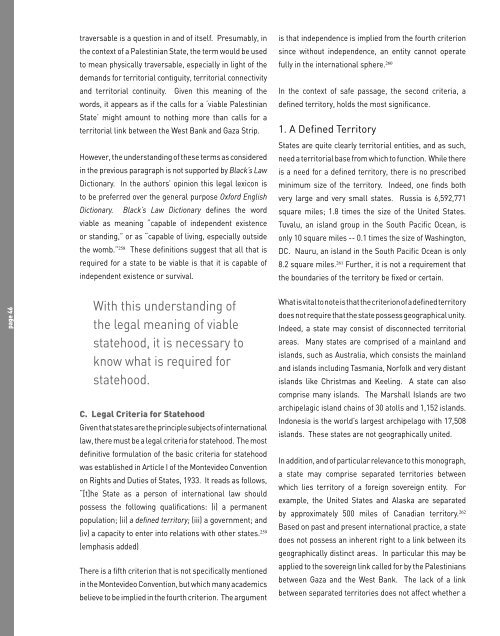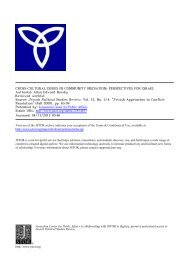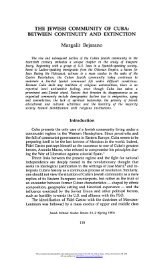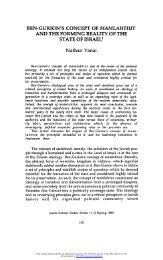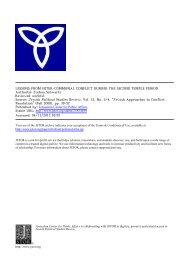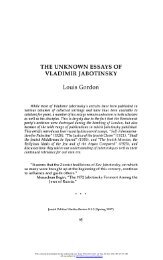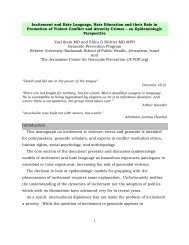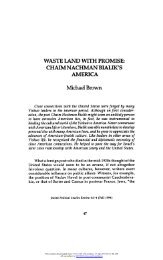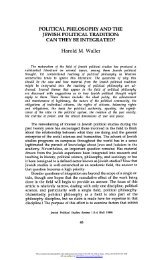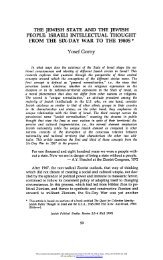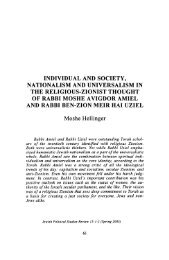Linking the Gaza Strip with the West Bank: - Jerusalem Center For ...
Linking the Gaza Strip with the West Bank: - Jerusalem Center For ...
Linking the Gaza Strip with the West Bank: - Jerusalem Center For ...
Create successful ePaper yourself
Turn your PDF publications into a flip-book with our unique Google optimized e-Paper software.
traversable is a question in and of itself. Presumably, in<strong>the</strong> context of a Palestinian State, <strong>the</strong> term would be usedto mean physically traversable, especially in light of <strong>the</strong>demands for territorial contiguity, territorial connectivityand territorial continuity. Given this meaning of <strong>the</strong>words, it appears as if <strong>the</strong> calls for a ‘viable PalestinianState’ might amount to nothing more than calls for aterritorial link between <strong>the</strong> <strong>West</strong> <strong>Bank</strong> and <strong>Gaza</strong> <strong>Strip</strong>.However, <strong>the</strong> understanding of <strong>the</strong>se terms as consideredin <strong>the</strong> previous paragraph is not supported by Black’s LawDictionary. In <strong>the</strong> authors’ opinion this legal lexicon isto be preferred over <strong>the</strong> general purpose Oxford EnglishDictionary. Black’s Law Dictionary defines <strong>the</strong> wordviable as meaning “capable of independent existenceor standing,” or as “capable of living, especially outside<strong>the</strong> womb.” 258 These definitions suggest that all that isrequired for a state to be viable is that it is capable ofindependent existence or survival.is that independence is implied from <strong>the</strong> fourth criterionsince <strong>with</strong>out independence, an entity cannot operatefully in <strong>the</strong> international sphere. 260In <strong>the</strong> context of safe passage, <strong>the</strong> second criteria, adefined territory, holds <strong>the</strong> most significance.1. A Defined TerritoryStates are quite clearly territorial entities, and as such,need a territorial base from which to function. While <strong>the</strong>reis a need for a defined territory, <strong>the</strong>re is no prescribedminimum size of <strong>the</strong> territory. Indeed, one finds bothvery large and very small states. Russia is 6,592,771square miles; 1.8 times <strong>the</strong> size of <strong>the</strong> United States.Tuvalu, an island group in <strong>the</strong> South Pacific Ocean, isonly 10 square miles -- 0.1 times <strong>the</strong> size of Washington,DC. Nauru, an island in <strong>the</strong> South Pacific Ocean is only8.2 square miles. 261 Fur<strong>the</strong>r, it is not a requirement that<strong>the</strong> boundaries of <strong>the</strong> territory be fixed or certain.page 46With this understanding of<strong>the</strong> legal meaning of viablestatehood, it is necessary toknow what is required forstatehood.C. Legal Criteria for StatehoodGiven that states are <strong>the</strong> principle subjects of internationallaw, <strong>the</strong>re must be a legal criteria for statehood. The mostdefinitive formulation of <strong>the</strong> basic criteria for statehoodwas established in Article I of <strong>the</strong> Montevideo Conventionon Rights and Duties of States, 1933. It reads as follows,“[t]he State as a person of international law shouldpossess <strong>the</strong> following qualifications: (i) a permanentpopulation; (ii) a defined territory; (iii) a government; and(iv) a capacity to enter into relations <strong>with</strong> o<strong>the</strong>r states. 259(emphasis added)There is a fifth criterion that is not specifically mentionedin <strong>the</strong> Montevideo Convention, but which many academicsbelieve to be implied in <strong>the</strong> fourth criterion. The argumentWhat is vital to note is that <strong>the</strong> criterion of a definedterritorydoes not require that <strong>the</strong> state possess geographical unity.Indeed, a state may consist of disconnected territorialareas. Many states are comprised of a mainland andislands, such as Australia, which consists <strong>the</strong> mainlandand islands including Tasmania, Norfolk and very distantislands like Christmas and Keeling. A state can alsocomprise many islands. The Marshall Islands are twoarchipelagic island chains of 30 atolls and 1,152 islands.Indonesia is <strong>the</strong> world’s largest archipelago <strong>with</strong> 17,508islands. These states are not geographically united.In addition, and of particular relevance to this monograph,a state may comprise separated territories betweenwhich lies territory of a foreign sovereign entity. <strong>For</strong>example, <strong>the</strong> United States and Alaska are separatedby approximately 500 miles of Canadian territory. 262Based on past and present international practice, a statedoes not possess an inherent right to a link between itsgeographically distinct areas. In particular this may beapplied to <strong>the</strong> sovereign link called for by <strong>the</strong> Palestiniansbetween <strong>Gaza</strong> and <strong>the</strong> <strong>West</strong> <strong>Bank</strong>. The lack of a linkbetween separated territories does not affect whe<strong>the</strong>r a


